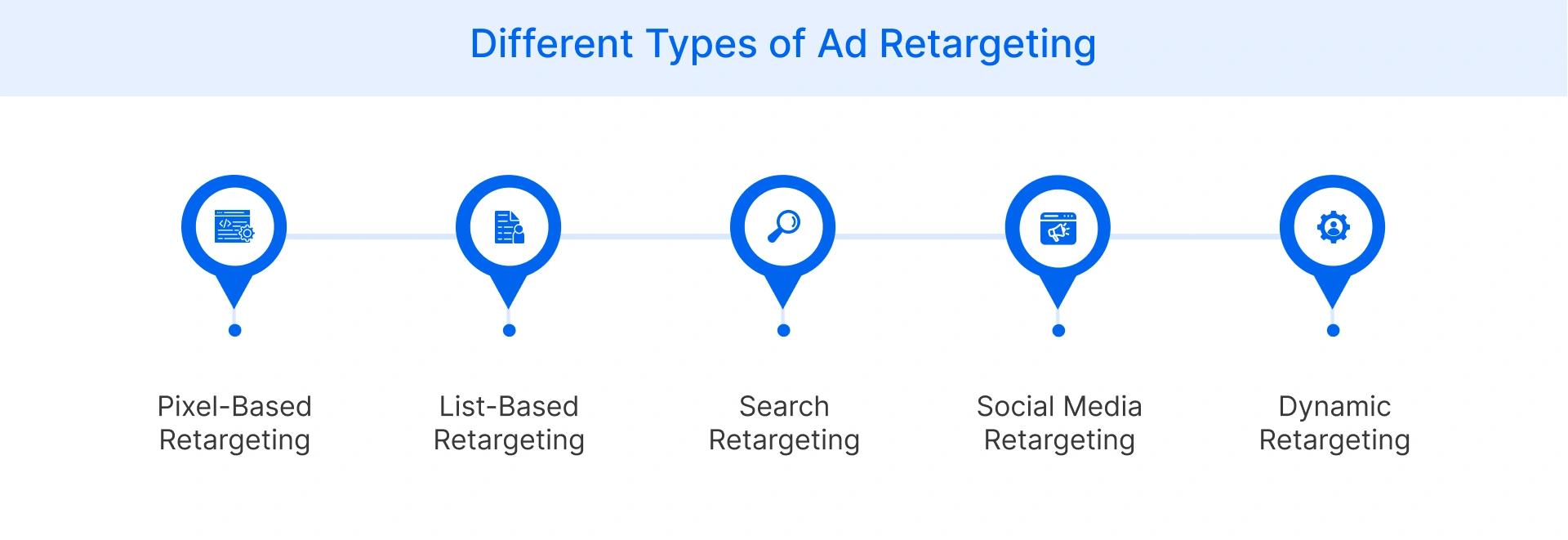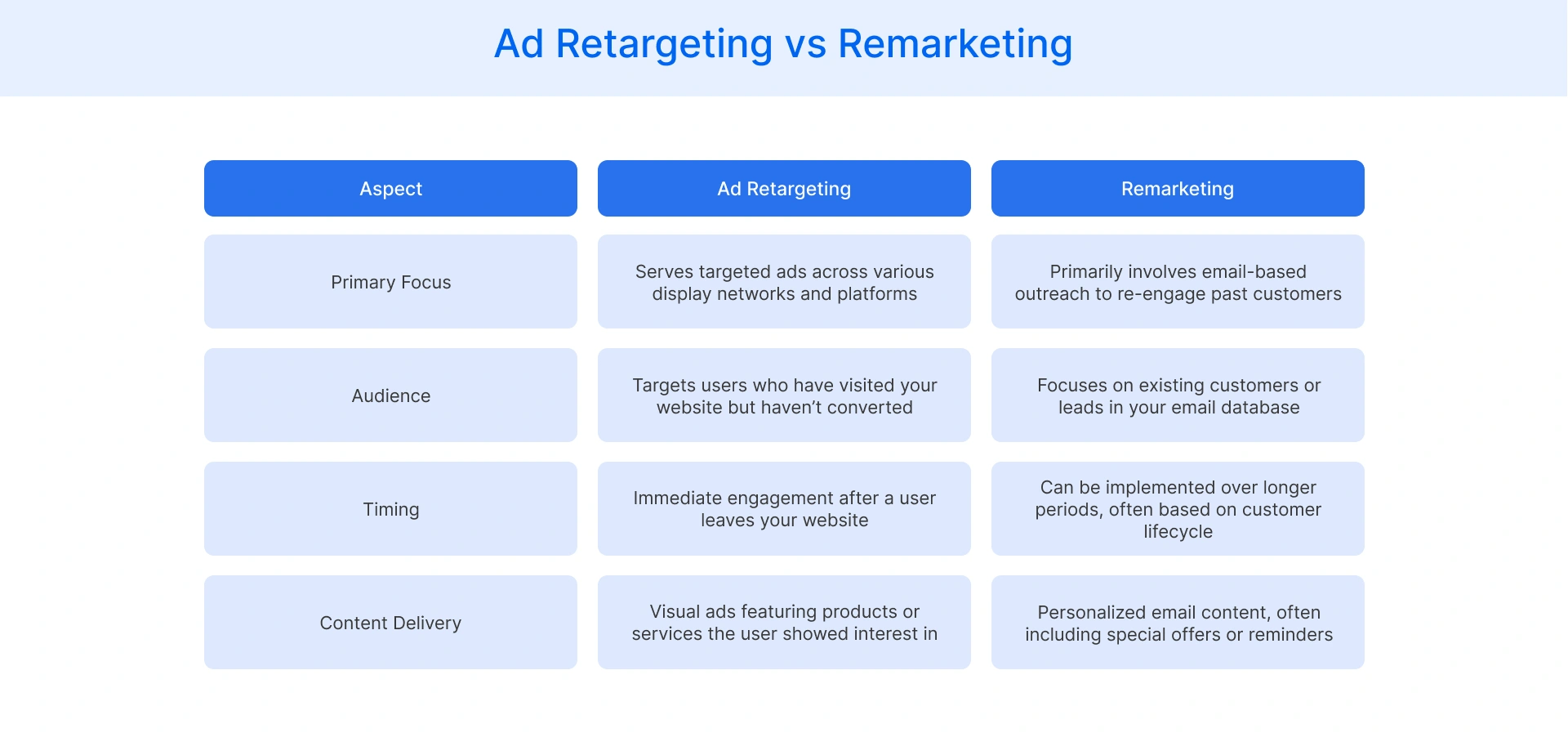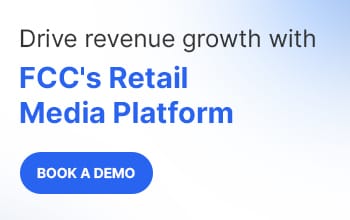Table of Contents
- What is Ad Retargeting?
- How Ad Retargeting Works?
- Types of Ad Retargeting
- Benefits of Ad Retargeting
- Ad Retargeting vs. Remarketing
- Challenges and Limitations of Ad Retargeting
- Best Practices for Running an Effective Retargeting Campaign
- Conclusion
What is Ad Retargeting?
Ad retargeting is a targeted advertising approach that reconnects with users who engage with a brand's website, app, or digital platform but do not complete a desired action, such as making a purchase or signing up for a newsletter. By displaying tailored ads across websites, social media platforms, and search engines, ad retargeting helps keep brands at the top of users' minds and encourages them to return and convert.
This strategy relies on tracking technologies like cookies and retargeting pixels to identify users based on their past interactions on a product page or an online store. When users leave a website without converting, retargeting platforms deliver personalized ads that highlight previously viewed products, services, or offers. Ad retargeting helps boost brand recall and increase conversion rates by presenting relevant content to already interested target people across the internet at the right time.
How Ad Retargeting Works?
Ad retargeting operates by tracking user interactions with your website or app through small pieces of code called pixels or cookies. These trackers collect data on user behavior, such as pages visited, or products viewed. When users leave your site without converting, the retargeting system identifies them on other platforms.
It then serves personalized ads based on their previous interactions, appearing on various channels like display networks, social media, or email. This process leverages audience segmentation to ensure ads are relevant and timely, increasing the likelihood of re-engagement and conversion.
Technologies for Retargeting
Ad retargeting relies on a suite of advanced technologies to deliver personalized, timely advertisements to potential customers. Here’s an overview of the key tools and platforms:
- Tracking Pixels: Invisible code snippets embedded in your website that collect user data and behavior patterns. They enable precise audience targeting and personalized ad delivery across various platforms.
- Cookies: Small text files stored in users’ browsers that help identify and track their online activities across different websites. They allow for consistent and relevant ad experiences throughout their browsing journey.
- CRM Integrations: Connect your customer relationship management system with retargeting platforms to leverage first-party data for more personalized campaigns, enhancing customer insights and targeting accuracy.
- AI-Driven Platforms: Utilize machine learning algorithms to analyze user behavior, predict intent, and optimize ad delivery in real-time, continuously improving campaign performance and ROI.
- Third-Party Platforms:
-
-
Google Ads Retargeting: Leverage Google’s vast display network to show ads to previous website visitors as they browse other sites, tapping into a wide array of placements and formats.
-
Facebook Ads: Use Facebook’s powerful targeting capabilities to retarget users on Facebook, Instagram, and partner apps. It creates a seamless cross-platform retargeting experience for your audience.
-
Programmatic Advertising Networks: Automate the buying and selling of ad inventory across multiple platforms. They help ensure wider reach and efficiency while optimizing ad placement based on user data and behavior.
-
Types of Ad Retargeting
Ad retargeting comes in various forms, each designed to re-engage potential customers based on different data points and user behaviors:
- Pixel-Based Retargeting: This method uses browser cookies to anonymously track website visitors. When users leave your site, pixel-based retargeting serves them relevant ads across other platforms they visit. It delivers the best results for immediate and behavior-based targeting.
- List-Based Retargeting: By uploading customer contact information to an ad platform, you can target specific users across digital channels. This approach is ideal for reaching known customers or leads with tailored messages based on their past interactions or preferences.
- Search Retargeting: This strategy targets users based on their previous search queries, even if they have not visited your website. It allows you to reach potential customers who have shown interest in products or services like yours through their search behavior.
- Social Media Retargeting: Platforms like Facebook, Instagram, and LinkedIn offer powerful retargeting options. You can show ads to users who have interacted with your social media profiles, engaged with your content, or visited your website, keeping your brand visible in their social feeds.
- Dynamic Retargeting: This advanced technique uses AI-driven personalization to serve highly customized ads. It tailors ad content based on specific products or pages a user has viewed, creating a more relevant and compelling ad experience that can significantly boost conversion rates.

Benefits of Ad Retargeting
Here are the key benefits offered by ad retargeting:
- Enhanced Brand Recall and Conversion Rates: Ad retargeting repeatedly exposes your brand to interested users, keeping your products or services at the top of mind. This increased visibility often translates into higher conversion rates, as users are more likely to complete a purchase when they are consistently reminded of your offerings.
- Improved Ad Relevance through Personalization: Ad retargeting allows you to create highly personalized ads based on users’ previous interactions with your website. This level of customization ensures that your ads resonate with your audience, increasing the likelihood of engagement and conversion.
- Better Return on Ad Spend (ROAS): Since you are targeting users who have already shown interest in your brand, ad retargeting typically yields a higher return on investment compared to broader advertising strategies. You are focusing your budget on warm leads, which often results in more efficient ad spend and improved ROAS.
- Reduced Cart Abandonment: Ad retargeting is particularly effective for ecommerce stores in recovering potential sales from users who have abandoned their shopping carts. By reminding these users of the products they were interested in through the right message, advertisers can significantly reduce cart abandonment rates and boost sales.
Ad Retargeting vs. Remarketing
Both ad retargeting and remarketing aim to re-engage potential customers, but they use different approaches and channels. Ad retargeting leverages display advertising networks to reach users across various websites and platforms, while remarketing primarily utilizes email marketing to reconnect with known contacts.
Understanding these distinctions can help you develop a comprehensive strategy that incorporates both techniques, maximizing your marketing effectiveness and driving conversions.

Challenges and Limitations of Ad Retargeting
While ad retargeting offers significant benefits, it also comes with several challenges that marketers must navigate:
- Issues Related to Cookie-Based Tracking: In a privacy-first digital world, reliance on cookies for tracking user behavior poses significant challenges. Users increasingly demand more privacy, making cookie-based tracking less effective.
- Ad Blockers Reducing Effectiveness: The growing adoption of ad blockers reduces the reach and impact of retargeting campaigns. This technology prevents ads from being displayed, thus limiting the effectiveness of ad retargeting efforts.
- Third-Party Cookie Deprecation: Major browsers gradually deprecate third-party cookies, disrupting traditional retargeting methods. To maintain effective retargeting strategies, companies need to shift towards first-party data solutions.
- Privacy Regulations: Compliance with data privacy regulations like GDPR and CCPA complicates ad retargeting. Ensuring data protection and user consent becomes critical for running compliant campaigns.
Best Practices for Running an Effective Retargeting Campaign
To maximize the impact of your ad retargeting efforts, consider implementing these best practices:
- Segment Your Audience Strategically: Divide your audience based on their behavior and engagement levels. Create distinct segments for users who viewed specific products, abandoned carts, or completed purchases. This granular approach allows you to tailor your messaging and offers more effectively.
- Optimize Ad Frequency: Strike a balance between visibility and oversaturation. Implement frequency capping to limit the number of times a user sees your ads within a given timeframe. This helps prevent ad fatigue and maintains a positive user experience.
- Craft Compelling Ad Creatives: Design visually appealing ads with clear, concise messaging. Use strong calls-to-action (CTAs) that prompt immediate action. Ensure your ad creatives align with your brand identity and resonate with each audience segment.
- Implement A/B Testing: Continuously test different ad elements such as headlines, images, CTAs, and ad formats. Use the insights gained from A/B tests to refine your campaigns and improve overall performance over time.
- Set a Burn Pixel: Implement a burn pixel to stop showing ads to users who have already converted. This prevents wasted ad spend and ensures you are not annoying customers with irrelevant ads post-purchase.
- Respect Data Privacy Regulations: Ensure your retargeting practices comply with data privacy regulations like GDPR and CCPA. Obtain proper consent for data collection and provide clear opt-out options for users who don’t wish to be retargeted.
Conclusion
Ad retargeting plays a crucial role in modern omnichannel retail strategies, bridging the gap between online and offline customer experiences. By leveraging data from various touchpoints, retailers can create personalized and timely campaigns that re-engage customers across multiple channels. At Flipkart Commerce Cloud (FCC), we offer comprehensive solutions to support your ad retargeting efforts within a broader omnichannel framework.
Our Omnichannel Order Management System seamlessly integrates your online and offline inventory, enabling real-time updates and efficient order fulfillment. This integration is key to executing successful retargeting campaigns based on accurate product availability.
FCC’s Advanced Analytics platform provides deep insights into customer behavior across channels, allowing you to create highly targeted retargeting segments. By combining these powerful tools with our expertise in the Indian e-commerce landscape, we empower retailers to deliver cohesive, personalized shopping experiences that drive conversions and foster customer loyalty.
FAQ
Frequency capping limits the number of times a user sees your retargeting ad within a specific timeframe. It's crucial because it prevents ad fatigue, which can lead to negative brand perception and decreased campaign effectiveness. By optimizing ad frequency, you can improve click-through rates and maximize the impact of your ad retargeting efforts.
Key metrics for ad retargeting success include click-through rate (CTR), conversion rate, and return on ad spend (ROAS). You should also monitor view-through conversions, which track users who saw your ad but converted later. Additionally, monitor frequency, reach, and engagement metrics to ensure your campaigns are effective without causing ad fatigue.
Pixel-based retargeting uses a JavaScript code to anonymously track website visitors and serve ads based on their browsing behavior. List-based retargeting, on the other hand, relies on your existing customer data, such as email lists, to target specific users across various platforms.

